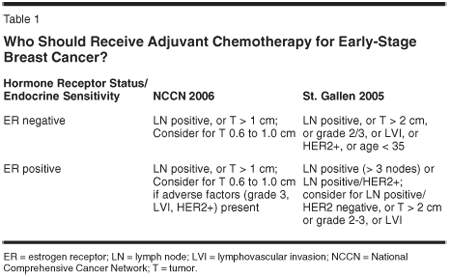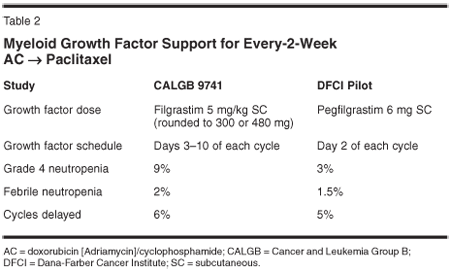Myeloid Growth Factor Support for Dose-Dense Adjuvant Chemotherapy for Breast Cancer
Anthracycline- and taxane-based adjuvant chemotherapy regimens have become the most commonly used regimens in the United States for high-risk, early-stage breast cancer. Growth factor support is an essential component of therapy for several of the most commonly used adjuvant chemotherapy regimens that frequently cause substantial myelosuppression and anemia. Extensive data now exist to demonstrate the efficacy of both long- and short-acting myeloid growth factors in patients receiving dose-dense AC → paclitaxel. This article will explore prophylactic use of both filgrastim (Neupogen) and pegfilgrastim (Neulasta) in recent clinical trials.
Anthracycline- and taxane-based adjuvant chemotherapy regimens have become the most commonly used regimens in the United States for high-risk, early-stage breast cancer. Growth factor support is an essential component of therapy for several of the most commonly used adjuvant chemotherapy regimens that frequently cause substantial myelosuppression and anemia. Extensive data now exist to demonstrate the efficacy of both long- and short-acting myeloid growth factors in patients receiving dose-dense AC → paclitaxel. This article will explore prophylactic use of both filgrastim (Neupogen) and pegfilgrastim (Neulasta) in recent clinical trials.
Most women diagnosed with breast cancer in the United States are found to have early-stage, operable breast cancer or locally advanced breast cancer, and are candidates for multimodality therapy to help prevent tumor recurrence. The risk of recurrence can be assessed based on a variety of pathobiologic factors. These include traditional pathologic criteria, such as larger tumor size, node-positive disease, presence or absence of hormone-receptor expression, overexpression of HER2, and histologic grade. Among node-negative breast cancers, larger size and the presence of lymphovascular invasion confer a greater risk of recurrence. Recent data suggest that among patients with estrogen receptor (ER)-positive, node-negative tumors, the recurrence score as measured by the OncotypeDX assay is a powerful predictor of recurrence. Clinicians use anatomic staging, bio-marker, and pathologic features to help select appropriate adjuvant therapy.
Chemotherapy and Neutropenic Risk
Adjuvant chemotherapy is frequently recommended to prevent tumor recurrence and promote survival in women with early-stage breast cancer. Current National Comprehensive Cancer Network (NCCN)[1] and St. Gallen[2] guidelines (Table 1) recommend adjuvant chemotherapy to large fractions of patients with early-stage breast cancer. These guidelines, particularly the more inclusive NCCN guidelines, suggest that most women diagnosed with breast cancer should consider chemotherapy.

Innumerable chemotherapy regimens are available for use as adjuvant treatment. The Early Breast Cancer Trialists' overview has suggested that anthracycline-based regimens are superior to nonanthracycline regimens.[3] The 2006 overview suggests an aggregate benefit for taxane-based therapy compared to nontaxane regimens (R. Peto, unpublished data). Based on these findings, and reports from individual clinical trials, anthracycline- and taxane-based adjuvant chemotherapy regimens have become the most commonly used regimens in the United States for high-risk, early-stage breast cancer. A variety of anthracycline- and taxane-based adjuvant treatment programs are available, including sequential regimens (AC → paclitaxel; AC → docetaxel; FEC → docetaxel) and combination regimens (TAC, AT).*
One common side effect of intensive taxane- or anthracycline-based regimens is neutropenia. The likelihood of neutropenia, and its clinically significant sequelae such as febrile neutropenia, mucositis, and neutropenic colitis, is a function of many factors including patient age, performance status, prior cancer treatment, comorbid conditions, and chemotherapy program. For women with early stage breast cancer receiving chemotherapy-many of whom are otherwise quite healthy-the most critical determinant of neutropenic risk is the dose and schedule of the chemotherapy program.
Growth Factor Support
Growth factor support has emerged as an essential component of therapy for several of the most commonly used adjuvant chemotherapy regimens that frequently cause substantial myelosuppresion and anemia. Myeloid growth factor support is necessary either by design-in order to facilitate timely administration of chemotherapy treatment-or because of practical necessity because of the risk of febrile neutropenia. An example of the former is "dose-dense" every-2-week administration of AC → paclitaxel. An example of the latter is TAC, which despite the use of prophylactic antibiotics carries a 25% risk of febrile neutropenia in the absence of myeloid growth factor support.
Current guidelines from the American Society of Clinical Oncology[4] and the NCCN[5] endorse prophylactic use of myeloid growth factors in patients receiving chemotherapy regimens with a risk of febrile neutropenia in excess of 20%, and consideration of such use for regimens carrying a risk of more than 10% when the goal of treatment is cure. For breast cancer patients, this would include adjuvant use of single-agent docetaxel, and combination regimens such as TAC or AT.
The AC followed by paclitaxel on an every-2-week schedule has emerged as the most widely used anthracycline- and taxane-based adjuvant chemotherapy regimen. The development of this regimen arose from the findings of Cancer and Leukemia Group B (CALGB) 9344, a randomized study of AC with or without the sequential addition of paclitaxel.[6] In CALGB 9344, sequential addition of paclitaxel improved on disease-free and overall survival compared to AC chemotherapy alone. Dose escalation of doxorubicin was also tested in this trial. Doxorubicin dose escalation to 90 mg/m2/cycle, given with granulocyte colony-stimulating factor (G-CSF, filgrastim [Neupogen]) support, did not improve clinical outcomes.
Accelerated Treatment Schedules
In order to advance the development of sequential anthracycline- and taxane-based regimens, CALGB 9741 examined an accelerated, every-2-week schedule of treatment vs the traditional every-3-week schedule. The historical use of every-3-week chemotherapy was not based on any scientific principle. Rather, it emerged from clinical experience which indicated that the 21-day cycle was required to allow normal neutrophil recovery to levels in excess of 1,500/m3, the level considered safe for readministration of the next cycle of chemotherapy. The arrival of effective myeloid growth factor support in the late 1990s allowed for an accelerated schedule of chemotherapy to be evaluated, as the neutrophil recovery time could be shortened with use of G-CSF.
CALGB 9741 demonstrated that this accelerated treatment program could improve clinical results, including better disease-free and overall survival, compared to every-3-week treatment.[7] Subsequent retrospective analyses have suggested that the improvements in disease control with accelerated chemotherapy are particularly realized in patients with hormone receptor-negative tumors.[8]
The use of myeloid growth factor support was essential to the administration of chemotherapy every 2 weeks in CALGB 9741. Prophylactic use of G-CSF was given on days 3 to 10 of each chemotherapy treatment cycle in order to facilitate the accelerated chemotherapy treatment. With this use of G-CSF, there was a low risk (2%) of febrile neutropenia in the dose-dense arms of CALGB 9741, a rate that compared quite favorably to the incidence among patients receiving every-3-week therapy (3% to 5%) without G-CSF. Follow-up to date does not suggest any increased risk of myelodysplasia or leukemia among the group of patients who received G-CSF therapy in either CALGB 9344 or CALGB 9741 compared to patients treated without G-CSF.
Pegfilgrastim
At the time that CALGB 9741 was organized, the only available G-CSF was the short-acting filgrastim product, requiring daily administration on days 3 to 10 of each chemotherapy cycle. By the time the results of CALGB 9741 were available, longer acting formulations such as pegfilgrastim (Neulasta) were available. Pegfilgrastim was developed in support of myelosuppressive chemotherapy regimens given once every 3 weeks. It has the advantage of requiring only one administration every 3 weeks, compared to the far-more frequent daily filgrastim injections. Unlike filgrastim, which is cleared by renal mechanisms, pegfilgrastim is cleared principally by recovery of neutrophils after treatment induced neutropenia. Typically, adequate recovery of neutrophils to clear pegfilgrastim arises near day 11 to 13 of a treatment cycle.
At Dana-Farber Cancer Institute, we sought to evaluate whether pegfilgrastim could be used in support of every-2-week adjuvant chemotherapy for early-stage breast cancer.[9] We administered pegfilgrastim on day 2 of each treatment cycle of 134 patients receiving dose-dense AC → paclitaxel, given on the same dose and schedule as in CALGB 9741. Pegfilgrastim proved to be quite effective as support for dose-dense AC → paclitaxel, with hematologic and treatment feasibility outcomes very similar to those seen in CALGB 9741 (see Table 2).

Based on these data, and the obvious convenience of once-per-cycle administration, pegfilgrastim has become our standard myeloid growth factor for use in patients receiving dose-dense AC → paclitaxel.
Pegfilgrastim has also been studied as growth factor support for patients receiving TAC or single-agent docetaxel chemotherapy, given on an every-3-week schedule.[10] For patients receiving single-agent docetaxel, the risk of febrile neutropenia was lowered from 17% to 1% with use of pegfilgrastim. These studies have demonstrated that pegfilgrastim can lower the incidence of febrile neutropenia among breast cancer patients receiving these chemotherapy regimens. Limited data from a randomized clinical trial suggest that with these intensely myelosuppressive regimens, pegfilgrastim should be administered on day 2 of each cycle, and not on day 1, to achieve effective prophylaxis.
Conclusions
Intensive anthracycline- and taxane-based adjuvant chemotherapy regimens are a fixture of current breast cancer care. Their successful and safe use depends on appropriate supportive care. Myeloid growth factor support is an integral part of that supportive care. Extensive data now exist to demonstrate the efficacy of both long- and short-acting myeloid growth factors in patients receiving dose-dense AC → paclitaxel. The administration of filgrastim/pegfilgrastim allows women to receive these important treatments in a timely and safe fashion, with minimal risk of neutropenic complications.
Disclosures:
The author has no significant financial interest or other relationship with the manufacturers of any products or providers of any service mentioned in this article.
References:
1. National Comprehensive Cancer Network: Breast cancer, v.2.2006. Available at: http://www.nccn.org/professionals/physician_gls/PDF/breast.pdf. Accessed October 9, 2006.
2. Goldhirsch A, Glick JH, Gelber RD, et al: Meeting highlights: International expert consensus on the primary therapy of early breast cancer 2005. Ann Oncol 16:1569-1583, 2005.
3. Early Breast Cancer Trialists' Collaborative Group: Effects of chemotherapy and hormonal therapy for early breast cancer on recurrence and 15-year survival: An overview of the randomized trials. Lancet 365:1687-1717, 2005.
4. Smith TH, Khatcheressian J, Lyman GH, et al: 2006 Update of Recommendations for the Use of White Blood Cell Growth Factors: An Evidence-Based Clinical Practice Guideline. Available at: http://www.asco.org/portal/site/ASCO/menuitem.c543a013502b 2a89de912310320041a0/?vgnextoid= f7af8c393c458010VgnVCM100000ed730ad1RCRD. Accessed October 9, 2006.
5. National Comprehensive Cancer Network. Myeloid Growth Factors, v.1.2006. Available at: http://www.nccn.org/professionals/physician_gls/PDF/myeloid_growth.pdf. Accessed October 9, 2006.
6. Henderson IC, Berry DA, Demetri GD, et al: Improved outcomes from adding sequential paclitaxel but not from escalating doxorubicin dose in an adjuvant chemotherapy regimen for patients with node-positive primary breast cancer. J Clin Oncol 21:976-983, 2003.
7. Citron ML, Berry DA, Cirrincione C, et al: Randomized trial of dose-dense versus conventionally scheduled and sequential versus concurrent combination chemotherapy as postoperative adjuvant treatment of node-positive primary breast cancer: First report of Intergroup C9741/Cancer and Leukemia Group B Trial 9741. J Clin Oncol 21:1431-1439, 2003.
8. Berry DA, Cirrincione C, Henderson IC, et al: Estrogen-receptor status and outcomes of modern chemotherapy for patients with node-positive breast cancer. JAMA 295:1659-1667, 2006..
9. Burstein HJ, Parker LM, Keshaviah A, et al: Efficacy of pegfilgrastim and darbepoetin alfa as hematopoietic support for dose-dense every 2 week adjuvant breast cancer chemotherapy. J Clin Oncol 23:8340-8347, 2005.
10. Vogel CL, Wojtukiewicz MZ, Carroll RR, et al: First and subsequent cycle use of pegfilgrastim prevents febrile neutropenia in patients with breast cancer: A multicenter, double-blind, placebo-controlled phase III trial. J Clin Oncol 23:1178-1184, 2005.